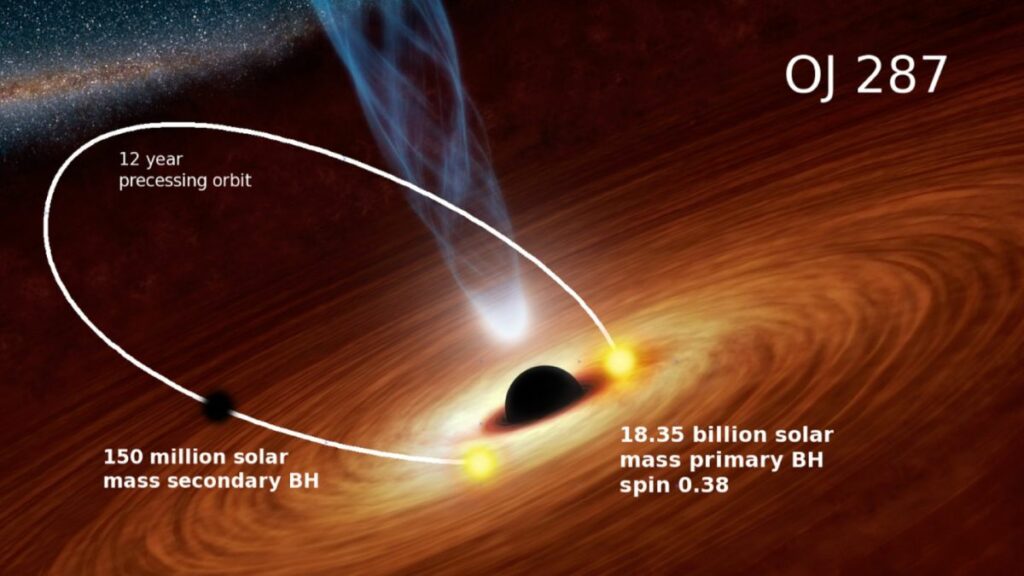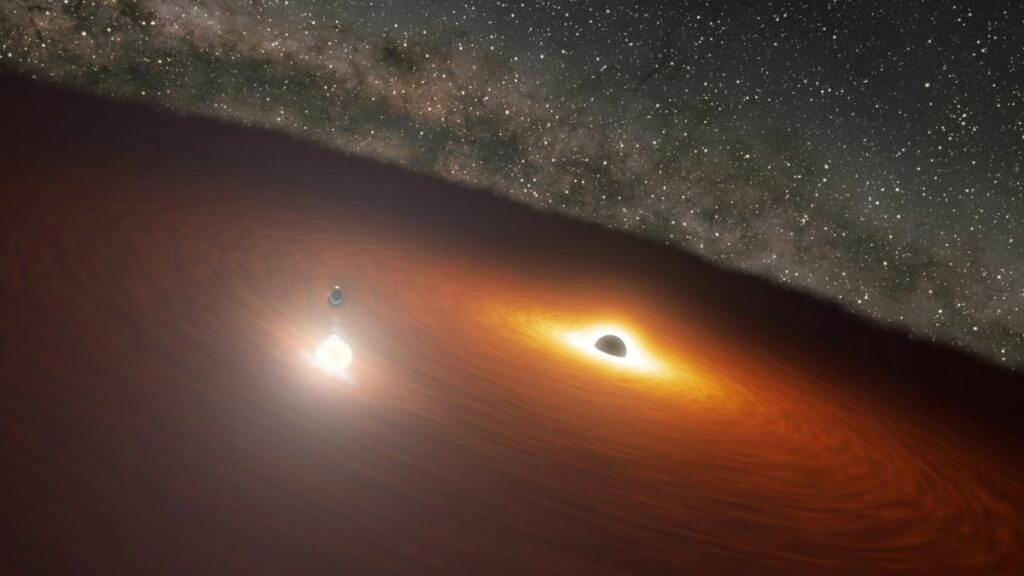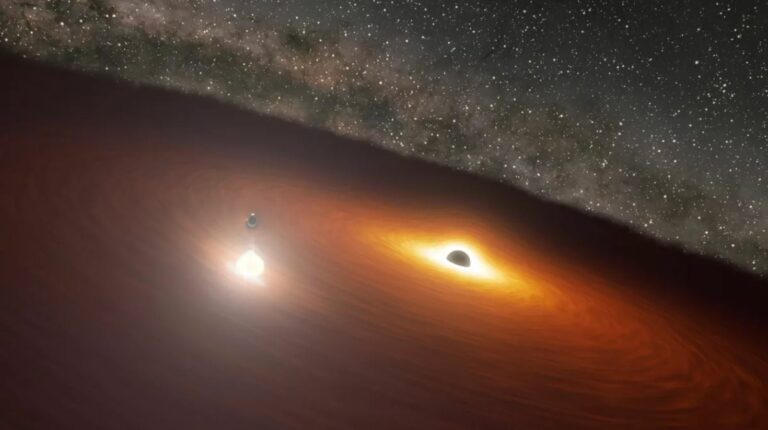Extraordinary Gamma-Ray Eruption Uncovers Twin Monstrous Black Holes, Emitting Light 100 Times Brighter than Our Galaxy
The presence of the second supermassive black hole is triggering powerful energy outbursts as it plunges through a searing-hot gas disk.
Astronomers have conclusively verified the existence of a second supermassive black hole residing in the turbulent core of a distant galaxy.
Furthermore, these scientists have uncovered a fascinating revelation: both of these colossal celestial entities are actively consuming gas and dust, while one of them follows an intriguing elongated orbit that propels it through an immense disk of scorching-hot gas and dust encircling its companion.
The newly discovered supermassive black hole, situated at the center of OJ 287—a galaxy positioned approximately 5 billion light-years away—boasts a mass equivalent to around 150 million suns. Despite its awe-inspiring magnitude, it pales in comparison to its companion, which tips the cosmic scales at over 18 billion solar masses. This dominant black hole voraciously gorges on the surrounding gas and dust, forming an accretion disk.
Within this tumultuous cosmic vortex, matter that does not plunge into the gravitational abyss of the supermassive black hole is channeled toward its poles, where it is expelled as powerful jets, illuminating the galactic core with an intense radiance known as a quasar—an active galactic nucleus (AGN).
The presence of a second orbiting supermassive black hole was detected within this accretion disk. As this second black hole descends through the swirling matter enveloping the primary black hole, it triggers a sequence of energetic outbursts.
These outbursts materialize when the diving black hole heats the accretion disk, causing it to release hot gas in the form of expanding bubbles. Over the course of several months, these gas bubbles cool down, emitting light and generating flashes that persist for approximately two weeks. Remarkably, these flashes are brighter than the collective radiance emitted by trillions of stars or the entirety of the Milky Way’s luminosity.
Through their research, astronomers have succeeded in accurately predicting the timing of the second black hole’s passages through the accretion disk. This breakthrough enables them to model both the flattened, elongated trajectory of the second black hole and the precise timing of the accompanying flares generated within the accretion disk.

Hidden monster
Over 120 years ago, the quasar OJ 287 was discovered in photographic plates, located in the constellation Cancer.
Although this quasar had been extensively examined, observations portrayed the black holes as a merged single point. It was only when astronomers detected two distinct types of signals that they began to speculate about the binary nature of this active galactic nucleus (AGN).
Approximately four decades ago, Aimo Sillanpää, an astronomer from the University of Turku in Finland and co-author of the recent study, along with colleagues, noticed a prominent emission pattern from OJ 287. They identified two cycles—a shorter one of approximately 12 years and a longer one of about 55 years. These cycles indicated the presence of two black holes orbiting each other, with the shorter cycle corresponding to their orbital period and the longer cycle arising from the gradual shift in the orientation of their orbit over time.
“The proximity of the two black holes in the sky makes them indistinguishable as separate entities; they appear as a single point in our telescopes,” explained Mauri Valtonen, an astronomer from the University of Turku in Finland and the lead researcher. “Only when we observe distinct signals from each black hole can we confidently claim that we have ‘seen’ both of them.”
During an observational campaign conducted by multiple telescopes in 2021 and 2022, astronomers finally acquired direct evidence of the secondary black hole’s descent through the accretion disk, while capturing signals emitted by this second cosmic behemoth.
“The period in 2021/2022 held special significance in the study of OJ 287,” noted Valtonen. “Previous predictions indicated that during this timeframe, the secondary black hole would plunge through the accretion disk of its more massive companion. This event was expected to generate a distinct blue flash shortly after the impact, and indeed, it was observed within days of the predicted time.”

Explosive surprises
Despite aligning with previous predictions, the recent observations brought forth some unexpected findings. One remarkable discovery was the identification of flare types that had not been previously detected, including an enormous flare that surpassed the brightness of an entire galaxy and lasted only a single day.
“Based on estimates, the flare occurred shortly after the smaller black hole received a substantial amount of new gas to consume during its plunge,” explained Valtonen. “It is this consumption process that leads to the sudden intensification of OJ287. It is believed that this process energizes the jet emanating from the smaller black hole within OJ 287. Such an event was predicted a decade ago but has now been confirmed.”
When the secondary black hole descended through the accretion disk surrounding its larger companion, it generated a powerful outburst of gamma rays, marking the most significant gamma-ray emission observed from this system in six years. This gamma-ray burst resulted from a jet of material expelled by the secondary black hole colliding with the gas present in the main accretion disk. The scientists corroborated this by examining archival data and discovering a similar gamma-ray burst in 2013—the last instance when the smaller black hole traversed the accretion disk.
“Now, what about the one-day burst? Why hadn’t we observed it before?” questioned Valtonen. “It appears that it was simply a matter of unfortunate timing. No one had observed OJ287 precisely on those nights when it performed its one-day spectacle.”
While astronomers will persist in studying the binary black hole system at the core of OJ 287 across various segments of the electromagnetic spectrum using an array of telescopes, the confirmation of this binary pairing renders the system an exceptional candidate for the detection of gravitational waves. Gravitational waves are minute ripples in the fabric of space-time that arise when massive objects accelerate and orbit one another. These waves gradually extract angular momentum from binary systems, causing the objects to spiral closer together. Consequently, the two black holes within OJ 287 will eventually merge, giving rise to an even more colossal supermassive black hole.
The team’s research is published in the journal Monthly Notices of the Royal Astronomical Society.
Do not forget to share your opinion with us to provide you with the best posts !




0 Comments